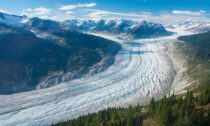
The world’s glaciers are melting at an accelerating rate, according to a comprehensive new study. A French-led team assessed the behaviour of nearly all documented ice streams on the planet. The researchers found them to have lost almost 270 billion tonnes of ice a year over the opening two decades of the 21st Century. The meltwater produced now accounts for about a fifth of global sea-level rise, the scientists tell Nature journal.
The numbers involved are quite hard to imagine, so team member Robert McNabb, from the universities of Ulster and Oslo, uses an analogy.
“Over the last 20 years, we’ve seen that glaciers have lost about 267 gigatonnes (Gt) per year. So, if we take that amount of water and we divide it up across the island of Ireland, that’s enough to cover all of Ireland in 3m of water each year,” he says on this week’s edition of Science In Action on the BBC World Service.
“And the total loss is accelerating. It’s growing by about 48Gt/yr, per decade.”
The worldwide inventory of glaciers contains 217,175 ice streams.
Some are smaller than a football pitch; others can rival in area a mid-sized country like the UK. What nearly all have in common is that they are thinning and retreating in a changing climate, either through stronger melting in warmer air or because the patterns of snowfall that feed the glaciers have shifted.
The research team, led by Romain Hugonnet from the University of Toulouse, France, used as its primary source of data the imagery acquired by Nasa’s Terra satellite, which was launched in 1999.
Immense computing power was brought to bear on the process of interpreting these pictures and pulling out the changes in the glaciers’ elevation, volume and mass up to 2019.
The team believes its approach has hammered down the uncertainties in its results to perhaps less than 5% overall. That’s in large part because every single glacier examined in the study is represented based on the same methodology.
“This new study is a major advance as we get a high spatial resolution and, at the same time, it also provides the temporal change over the two decades directly based on satellite data, which is novel,” explained co-author Matthias Huss from the Swiss Federal Institute of Technology.
“This data-set has been validated with an immense amount of additional, independent measurements and is highly accurate so that the uncertainties of previous studies are strongly reduced.”
A group led from Leeds University published its own assessment of glacier ice loss in January in the journal The Cryosphere.
It arrived at very similar numbers. It reported a 289Gt/yr average loss over the period 2000-2019, with a 52Gt/yr/decade acceleration. An 8% difference.
Leeds professor Andy Shepherd told BBC News: “Glacier melting accounts for a quarter of Earth’s ice loss over the satellite era, and the changes taking place are disrupting water supplies for billions of people downstream – especially in years of drought when meltwater becomes a critical source.
“Although the rate of glacier melting has increased steadily, the pace has been dwarfed by the accelerating ice losses from Antarctica and Greenland, and they remain our primary concern for future sea-level rise.”












Social Profiles